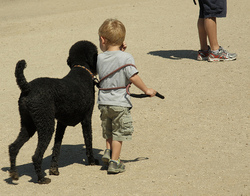Sharing our lives with dogs has changed dramatically over the past couple of decades, and by and large that's been a good thing for them. Better treatment of canines, our better understanding of the species as a whole and by the sum of its parts by experts, better health care and more has been helpful.
The area of canine cognition has grown vigorously, which is also important for more reasons than I can count.
As dogs have been brought into our lives in a more inclusive capacity, the whole dynamic of their behavior has changed. Dogs have had to evolve quickly. We expect more out of them - sometimes too much - and in order for them to exist in a more civilized way so that they can be with us inside our homes, the need for us as humans to learn to modify their natural instincts and behaviors has become a necessity.
An unfortunate side effect of this change has been the anthropomorphism of animals as a whole.
Ask anyone who lives with pets how they perceive the animals' behavior, emotions and perceptions, and you'll get a wide range of answers.
That's not surprising, quite honestly. Considering all of the influences, like books, blogs, TV personalities, and sometimes very unqualified people that are out there telling dog owners what dogs think and feel, it happens a lot. Combine that with the preconceived notions that we have to draw from on our own personal experiences as humans, and people not knowing how to choose a dog trainer or behaviorist (if and when it's needed), and it's usually a recipe for disaster for canines.
 |
| flickr photo courtesy of Emery_Way |
I see many things in any given week that leave me with raised eyebrows as far as what pet owners say or do to with regard to the behavior of four-legged members of our world.
This past week was no exception. Surely you've seen the video of the "guilty" yellow lab circulating all over the internet, by now.
After seeing it myself last weekend, I was immediately incensed by the assertion that this pooch was somehow feeling guilty about getting into a package of cat treats. By mid-week, the video went viral.
Why do I feel this way? This video - and the circulation that it's gotten - along with the hordes of others like it on the internet give the wrong message. Good Morning America decided to do a segment on it as well, albeit tongue-in-cheek.
The video of the pooch conveyed anxiety and nervousness. Guilt? Not likely. Guilt is part of the human condition. A higher-order emotion.
It's difficult for most not to be anthropomorphic with dogs especially, but It's puzzling why we continue to place human emotions on canines to this degree. The practice leads people off track, especially where serious behavior problems are concerned.
Before we can help unfold a dog into the unique creatures that they are, we need to understand them on a level that is appropriate - not one that is tainted by our preconceived notions due to our human experiences.
Let's leave the postulating about dog behavior to animal behaviorists and ethologists, shall we? Dogs might be better served if we spend more time trying to understand higher-order emotions where they truly reside: In humans.
Read more on the topic of "dog guilt" and higher-order emotions by clicking here.
Lorrie Shaw is lead pets blogger for AnnArbor.com and frequently writes about dogs. She welcomes your contact via email, and to follow her daily adventures as owner of Professional Pet Sitting on Twitter.




